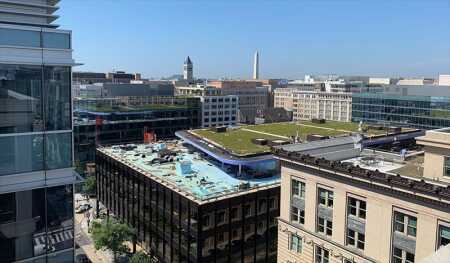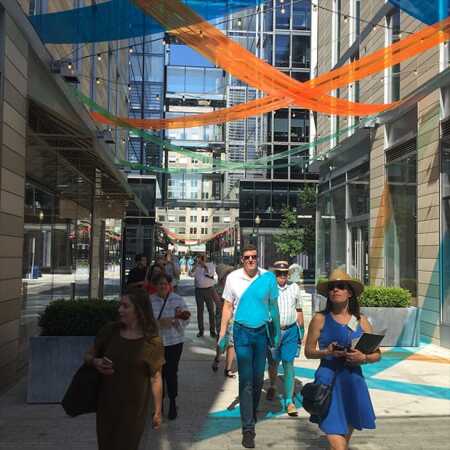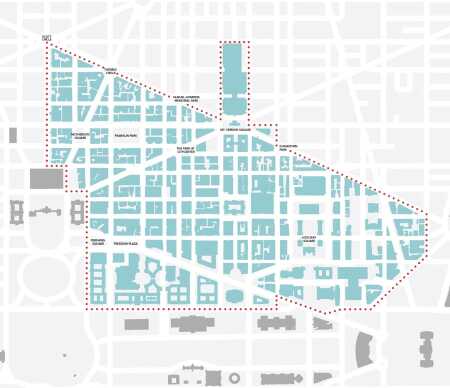When it comes to setting energy-efficiency standards for new and existing buildings, Washington, D.C.—which was designated as the first Leadership in Energy and Environmental Design (LEED) Platinum city in the world in 2017—has been ahead of the curve for a long time. And a new law signed by Mayor Muriel Bowser in January will push the market even further on high-efficiency building practices throughout the built environment. Under the Clean Energy D.C. Omnibus Amendment Act, the District is planning to move entirely to renewable electricity by 2032, with the goal of cutting the city’s greenhouse gas emissions in half by that year as part of its broader commitment to becoming entirely carbon neutral by 2050. To meet those goals, building owners will be required to make energy retrofits on about half of the buildings in the city.
To help owners prepare for these changes, ULI partnered with the DowntownDC Business Improvement District for an Advisory Services panel called “Addressing D.C.’s Climate Change Legislation and Regulation While Enhancing Value through Real Estate Investment in Sustainability.” The panel’s work entailed a week’s worth of research, interviews with 73 stakeholders, tours, and discussion among a group of eight invited real estate, finance, and sustainability experts, culminating with a panel discussion at CoStar’s headquarters building in July.
Lynn Thurber, a former global chairman of ULI, immediate past chairman of the advisory board for the Institute’s Center for Sustainability and Economic Performance, and the past chairman of global real estate money management firm LaSalle Investment Management, led the panel. Although the Clean Energy Act presents a host of challenges for building owners, she began the discussion by calling it inspirational.
“In order to accomplish the goals for 2032 and the vision for 2050, it will require unprecedented market transformation,” Thurber said. “Everyone must be on this journey together as a part of this. There is something in this for everyone, but everyone must be willing to listen to all perspectives, to do their best to understand those perspectives, and to work as partners to come up with solutions that are fair and economically feasible for everyone.”
The panel was organized through ULI’s Advisory Services program, which has been organizing industry leaders to help local communities address building, design, and environmental challenges since 1947. In addition to Thurber, the panel included ULI Trustee William G. Lashbrook III, senior vice president of PNC in East Brunswick, New Jersey; Kevin Bates, president of Sharp Development in Portola Valley, California; Laurie Kerr, senior policy adviser in the New York City Office of Long Term Planning and Sustainability; Alan Razak, principal of AthenenianRazak in Philadelphia; Jay Sholl, senior vice president at CBRE in San Francisco; Sarah Sieloff, executive director of the Center for Creative Land Recycling in Oakland, California; and Billy Grayson, executive director for the ULI Center for Sustainability and Economic Performance in Washington, D.C.
The question before the panel was how the DowntownDC Business Improvement District (BID) could help downtown building owners meet the District’s new sustainability goals in a cost-effective way. And the panelists dug into specifics. Grayson sorted some of the goals by the level of challenge they present: cutting greenhouse gas emissions by half and moving to 100 percent renewable energy by 2032 are achievable goals, he said. Implementing the District’s Building Energy Performance Standards (BEPS) and moving to net-zero energy for new construction by 2026 are goals that are “achievable but hard,” and the panel concluded that supplying 5 percent of the District’s renewables from local solar projects may be impossible. The goals will hinge on whether there will be enough education, resources, funding, and time to complete the necessary work. Public programs intended to help building owners should be quick to roll out in order to meet the goals, he said.
Designing and building to net-zero energy standards requires a range of tactics, said Bates, who specializes in energy retrofits for commercial buildings in Silicon Valley. Owners will need to corral mechanical engineers, electrical engineers, general contractors, architects, solar contractors, and others to form plans together. And developers should avoid looking at the return on investment (ROI) of any individual product in isolation, and instead weave together a range of solutions and consider the ROI as a whole, because “the sum is more cost-effective than the parts.” The typical ROI timeline for a net-zero energy retrofit is five to six years, Bates said. It is also critical to enlist tenants in the project of energy efficiency, educating them on energy use and considering the sustainability goals when fitting out tenant spaces, Sholl said.
Public entities in the District can assist in the transformation of buildings if they expedite the regulatory processes for achieving energy retrofits, and create more incentives for building owners to complete the retrofits quickly, said Sieloff, who also used to work in the Obama administration. The District should also consider creating a Clean Energy “Champion” position, a single person who would be in charge of coordinating efforts and helping building owners answer questions and find resources to aid the work. Also at the local level, said Kerr, District officials should consider complementing the new requirements with tax subsidies, funding for net-zero energy retrofits, submetering of commercial tenants, and relaxing some zoning restrictions that make energy retrofits more difficult.
For the DowntownDC BID, Razak said, near-term priorities should include educating building owners, providing assistance for energy benchmarking and auditing, offering workforce training, creating case studies of successful projects, and helping connect members with financial resources and investments, including from the city’s new Green Bank. The panel also recommended that the BID appoint a BID sustainability leader to help building owners navigate the work that needs to be done.
Throughout the panel, building owners were encouraged to start the work the moment they left the room, because the timeline for achieving the Clean Energy DC goals is tight. As Thurber said, “Yesterday is not too soon.” The eight panelists spent the week writing a draft of the written report that will include its recommendations for next steps for the BID and for building owners in the District. ULI staff will complete the report in the coming weeks.
“This is ULI’s commitment to sustainability and economic performance—our belief that sustainability and resilience are crucial to the future of the planet and creating and sustaining thriving communities,” Thurber said after the panel.
During a question-and-answer session, Katie Bergfield, an official with the District’s Department of Energy and Environment, introduced herself and offered to help members work through the requirements. Neil Albert, the president and CEO of the DowntownDC BID, also set up an appointment with the department to discuss the panel’s findings.
“That just pleases me to no end,” Thurber said after the panel. “That at the end of this presentation, the partnering that we were talking about—that’s going to be essential—is already scheduled to happen.”
At the 2019 ULI Fall Meeting, hear from three mayors about how they are thinking about the future at a panel discussion titled “The City in 2100: A View from the Mayor’s Office”. ULI Advisory Services staff and panelists will also discuss some of their recent work. ULI members can find this and hundreds of other Advisory Services panel reports and presentations on Knowledge Finder.







